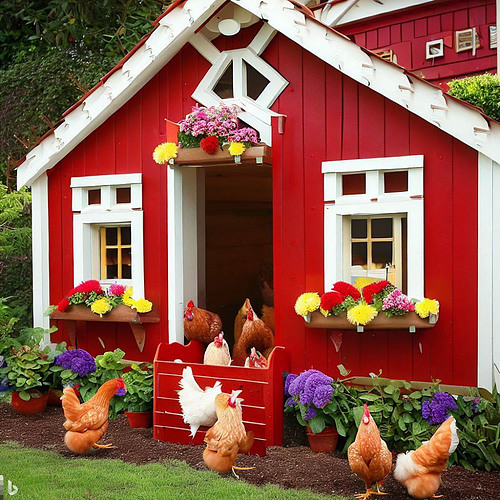Raising backyard chickens can be a joy, but providing a safe and comfortable home for your feathered friends is a necessity. That’s where backyard chicken coops come in handy. In this post, we’re going to cluck about some egg-citing coop plans and designs that are sure to ruffle your creativity!
The Basics of Backyard Chicken Coops
A chicken coop isn’t just a place for your hens to rest their weary wings—it’s their fortress, their sanctuary, and the place they’ll lay their golden treasures (aka eggs). Coops should provide safety, enough space for each chicken to roost comfortably, and sufficient ventilation to keep the air fresh. That’s for your chickens. What about you?
What am I talking about? In order for your chicken-rearing experience to be completely enjoyable, the coop has to be big enough for you to get around in easily for cleaning, changing bedding, gathering eggs, and doing whatever other chores that are necessary to efficiently tend to your flock’s coop needs.
Factors to Consider When Building a Chicken Coop
- Space: Each chicken should have at least 2-3 square feet of space inside the coop, plus an additional 8-10 square feet in an outside run.
- Accessibility: Design your coop so it’s easy to clean, and eggs are easy to collect.
- Materials: Choose durable, weather-resistant materials. Remember, what you invest now will save you from future repairs.
- Predator-Proofing: Reinforce your coop’s security with predator-resistant latches and fencing.
Designing Your Backyard Chicken Coop
Coop Designs for Small Flocks
An A-Frame coop is a popular choice for small flocks. Its triangular design is relatively easy to build and move around. Another excellent option is a Tractor-style coop, which is mobile and allows chickens to graze on fresh grass.
Coop Designs for Large Flocks
For larger flocks, the walk-in Style coop is a great option. It provides ample space and allows easy access for cleaning and maintenance. Alternatively, the Multi-Level coop maximizes vertical space, offering more room for chickens to roost and play.
Planning Your Chicken Coop
Location in Your Backyard
Consider the direction of sunlight and wind. Position your coop so it gets some morning sun (to help dry the dew) but stays shaded during the afternoon heat.
Material List and Budgeting
Wood is the most common material for a coop, but you’ll also need wire mesh for ventilation and security, along with hardware for assembly. Consider your budget and where you can source materials.
Other options include sheet metal and plastic sheathing. Each has its advantages and disadvantages. Metal and plastic aren’t as easy to work with as wood, but you don’t have to worry about rot or parasites as much as when working with wood.
DIY vs. Buying Pre-Made Coops
While building a coop can be a rewarding project, buying a pre-made one is a time-saving option. Choose the route that best suits your resources and skills.
Just make sure you are careful when selecting pre-made coops. Quality varies greatly from source to source. You do indeed get what you pay for.
Detailed Chicken Coop Plans
Looking for detailed plans? Websites like EasyCoops.com offer a variety of free and paid plans with illustrations, dimensions, and more. Customize these plans based on your needs and backyard space.
Maintaining Your Chicken Coop
Remember, a well-maintained coop is key to a healthy flock. Regular cleaning, weatherproofing, and predator-proof checks should be part of your routine. Keep an eye out for signs of wear and tear and address them promptly.
In conclusion, building a backyard chicken coop that suits your flock can be an egg-ceptionally rewarding endeavor. Remember, the key to a successful coop lies in the planning, design, and maintenance. Happy clucking!

